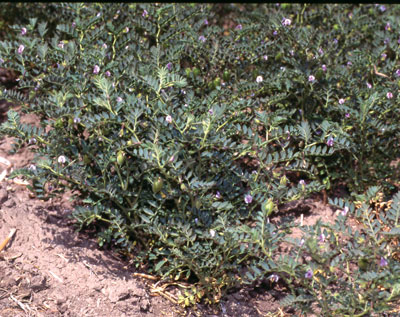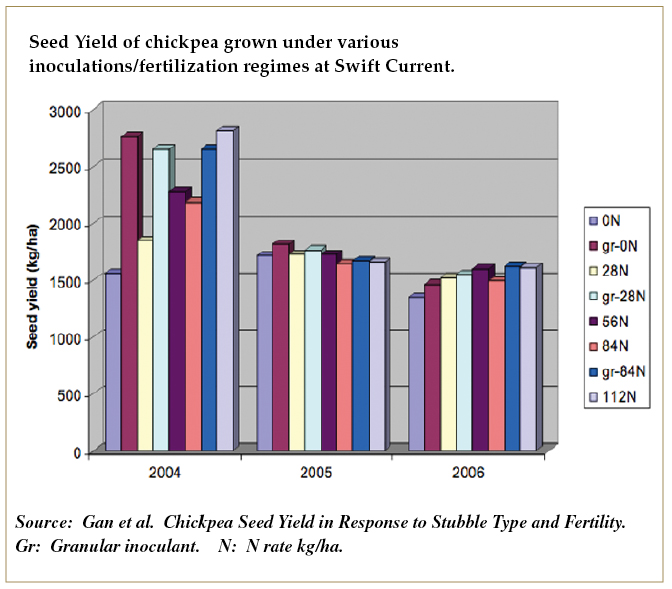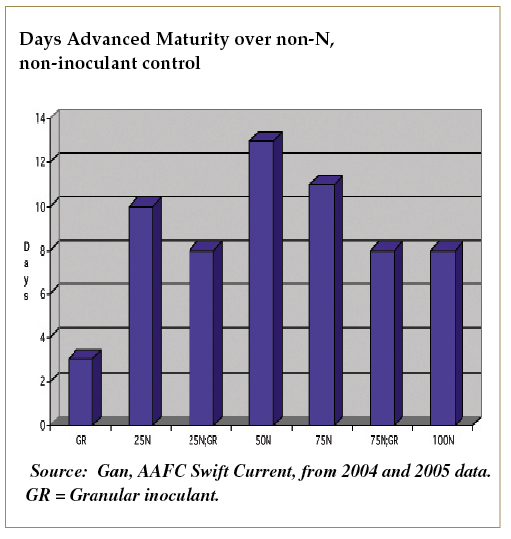
Features
Agronomy
Diseases
Stabilizing chickpea yields
From an experimental crop in the 1990s to a crop grown on several hundred thousand acres today, chickpea has provided growers with their fair share of heartbreak and happiness.
February 24, 2009 By Top Crop Manager
From an experimental crop in the 1990s to a crop grown on several hundred thousand acres today, chickpea has provided growers with their fair share of heartbreak and happiness. Today, though, growers can look back on years of research and practical experience to produce a dependable, quality product. “If you look at beneficial management practices, we have been able to develop a good research base that will help produce stable chickpea yields,” says Yantai Gan, a research scientist at the Semiarid Prairie Agricultural Research Centre at Swift Current, Saskatchewan.
 |
|
| Research has helped to develop BMPs to reduce production risk in chickpea.
|
Seeding
Research has shown that seeding the thin-coated kabuli chickpea should be delayed until the soil temperature at the 10cm (six-inch) depth reaches a minimum of 8 C. The thin seed coat of kabuli allows rapid water uptake and easy infection by seed rot fungi like Phythium. Seed treatment with Apron FL can help reduce seed rot, and can allow earlier planting into soils slightly cooler than 10 C. “You can’t put kabuli chickpeas in the ground too early or they will be affected by soil-borne disease. On a multiple crop farm, plant oilseeds like mustard or canola first, then pulses with peas first, then lentils and desi chickpeas almost as early as lentils and then kabuli chickpea,” explains Gan. “Cereals can be planted anytime in the spring from late April to late May, but earlier is better for cereals too.”
Seeding rate was also investigated to see how plant stands influenced ascochyta blight infection, yield and quality. In one of Gan’s study, he looked at the effect of variety and plant stand to see if they affected ascochyta. The four-year study covered wet and dry years, and compared eight kabuli and desi varieties, including fern and unifoliate leaf types. Gan says that the study still provides a good lesson in ascochyta management and yield. “Unless plant populations are extremely high, in the 70 to 80 plants per square metre range, I don’t think plant population is an issue with ascochyta infections. Environment is the key. If it rains and the inoculum is present, you will get the disease,” says Gan.
The study showed that fern leaf varieties had lower disease ratings than unifoliate type varieties under the same environmental conditions, and this factor played an important role in cases where the disease is moderate to high. However, all varieties are subject to be diseased when environmental conditions are favorable to the pathogen. Gan explains that variety selection is more important than plant density, and that CDC Frontier, grown on approximately 70 percent of chickpea acreage in 2008, has become popular because it has better ascochyta disease resistance than other varieties. “With CDC Frontier, growers generally spray at the seven node stage, which is two to three weeks before flowering. Then if the weather becomes more favourable for disease development, i.e., rains, producers will go back and spray at about the 12 node stage, about the time the plant starts to flower,” explains Gan. “In many cases, that’s all the fungicide that is needed for CDC Frontier, but other more susceptible varieties might need up to five fungicide applications.”Overall, higher plant population resulted in greater seed yield, largely because of more pods produced within a given area basis. Individual plants have a limited capacity to produce a certain number of pods; more pods per unit area can easily be achieved by seeding rate, rather than attempting to produce more pods per plant which is harder. More pods mean higher yield.
 |
|
 |
Managing N fertility
Gan’s research shows the large economic benefits of using Rhizobium inoculants. During three years at two sites, he compared nitrogen fertility programs that included inoculants and N fertilizer. When a granular inoculant was used, it produced seed yields as high as where N fertilizer was applied at a rate of 80 kg N per hectare (71 lbs per acre). “You can use either fertilizer N or an inoculant to produce the same yield, but no need to apply both. Use of fertilizer N, along with inoculant, is an approach to waste money” says Gan.
One area where fertilizer N might be of benefit is risk management. In a study where moderate amounts of N fertilizer was used, chickpea maturity was significantly earlier compared to the crops where non-inoculant and non-fertilizer N were used or only rhizobial inoculant was used. Varieties with later maturity responded to the fertilization more significantly than the relatively earlier maturing cultivars. “A moderate rate of fertilizer N, around 25 to 50 pounds per acre will advance maturity in a wet year,” says Gan. “This practice could be a good risk management strategy, not to increase yield, but to reduce the risk of late maturity, which affects
seed quality.”
Gan explains that under good growing conditions, the N-fertilized crop grew more vigorously in the early growing season and ran out of fertility late on, so the crop started to set seed. But for the crop that was well inoculated, it continued growing with good moisture conditions, so maturity was delayed.
To use nitrogen fertilizer as a maturity risk strategy, fields should have low residual soil N so that the crop runs out of N fertility later in the season, and stops its indeterminate growth. Fields with high residual nitrogen, in the area of 50 to 60 lbs/acre of available N, are not suitable for this strategy as the high N will allow the crop to continue to grow in wet years.